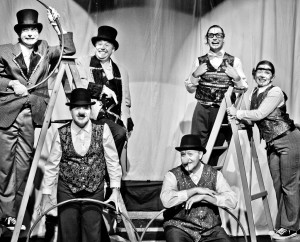Interesting but Cluttered Staging in The Creation of the World and Other Business

God created Adam and Eve, and on the seventh day he sat back and wondered, “But why haven’t they figured out how to procreate yet?” 9th Hour Theatre Company presents Arthur Miller’s The Creation of the World and Other Business, a story loosely based on the story of Genesis. In this production, director Jonathan Harris sets the story in a clown circus which shifts the story from parable to parody.
The script is far from what one might associate with Miller. Here, Miller does not present his audience with realism, and the story itself does not unfold in a realistic stage-world. Instead, The Creation of the World and Other Business presents an intangible setting (in this case, it is Earth during Creation) where he can examine the nebulous world of morality from a distance. The play presents other-worldly characters struggling with the first-ever moral dilemmas experienced by humankind. God and Lucifer enter many repartees concerning the balance of good and evil, God’s own vanity, and justice.
Harris has set the play inside what seems to be the backstage of a circus performance, turning this production into a “play within a play”. The audience surrounds three sides of the stage in a thrust-stage arrangement, which helps to emphasize the circus aesthetic of the production. The set is comprised of old trunks, two wooden ladders, and some clown-approved props (hoola-hoops and balloons, for example) which are rearranged to create the various locations of Miller’s play. The overall impression is of a dusty, warn-out circus tent in a deliberately nondescript time and place.
The ensemble cast are dressed as bedraggled clowns and weave in and out of the various roles in this play – from God, to Lucifer, Adam and Eve and two Archangels. While the circus-like setting provides some visual interest, it is at odds with the actual story presented. Though Harris has decided to portray a “play within a play”, the clowns do not live in both worlds. That is to say, the purpose of using a circus setting is not readily apparent, but for adding some visual interest. What’s more, the clowns do not seem to have characters dissociated from the ones they portray. In reality, they portray the characters in a fairly direct way. The clowns have little relevance in this story, except for some musical interludes that are used to transition between acts. The clown characters do not straddle the two worlds, as you might expect, which leads to some confusion when they decide to take on different roles. Ultimately, it’s a logical misfire.
Despite the discordance between the staging and the script, the ensemble cast manages to scramble into some really funny, and really dark moments. Through Lucifer’s misdirection, for example, he manages to send Eve, Cain and Able into an orgy-esque tailspin; a true and pure representation of the moral dubiousness which he represents. And while these moments are intense and captivating, in other moments the actors struggle to transition between characters, with their costuming, and sometimes with the staging itself. For example, the ladders are moved around the stage and sometimes create gapping obstructions to the sight-lines of the audience. With so much “business”, the strength of the actor’s performances varies greatly throughout the production. The staging comes across as unnecessarily cluttered.
The play highlights, above all, the strangeness of human morality, the seesaw of good and evil, and reveals a more complicated personification of God and Lucifer; the former, more arrogant, and the latter, more benevolent, than in conventional narratives. It’s meaty stuff, though this production may leave you craving a more straight-forward staging to reveal the heart of this script.